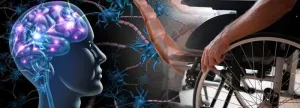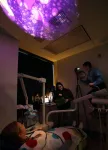(Press-News.org)
Among patients with extensive stage small-cell lung cancer (SCLC) that is positive for expression of the Schlafen-11 gene (SLFN11), those who received maintenance atezolizumab immunotherapy plus the PARP inhibitor talazoparib had significantly longer progression-free survival (PFS) times than those who received atezolizumab alone (median PFS 4.2 months versus 2.8 months).
These results from the phase II S1929 trial conducted by the SWOG Cancer Research Network, a clinical trials group funded by the National Cancer Institute (NCI), will be reported in an oral presentation at the 2023 meeting of the American Society for Clinical Oncology in Chicago on June 3.
The work was led and will be presented by Nagla Abdel Karim, MD, a SWOG investigator who directs the Early Therapeutics Program at the Inova Schar Cancer Institute and the University of Virginia.
“The results of S1929 demonstrate improvement in progression-free survival in patients with SLFN11-expressing small-cell lung cancer,” Karim said. “This is a groundbreaking milestone in building future studies for small-cell lung cancer towards a personalized approach to therapy. Progression-free survival is of great clinical significance, especially in this aggressive disease.”
The S1929 study randomized 106 patients who received front-line chemotherapy with atezolizumab and whose tumors tested positive for SLFN11 expression. All randomized patients were included in the analysis. Progression-free survival was the primary endpoint in the trial. Patients on the talazoparib arm had a risk of disease progression or death that was reduced by 30 percent (PFS hazard ratio [80% CI]: 0.70 [0.52-0.94]; p=0.056) compared to that for patients on the atezolizumab-only arm.
Secondary endpoints included overall survival. Median overall survival times were similar between the two arms (9.4 months in the investigative arm versus 8.5 months in the control arm).
Patients on the combination therapy did experience significantly more hematological adverse events (blood-based side effects) than those on the atezolizumab-only therapy (50 percent versus 4 percent), although this increased rate of hematological toxicity was expected. Non-hematological adverse event rates were similar between the two arms (15 percent versus 13 percent, respectively).
The authors note that the S1929 study results also demonstrate, for the first time, the feasibility of conducting biomarker-selected trials in patients with SCLC, which could pave the way for future trials that evaluate new therapies for the disease in selected patient populations.
“Managing small-cell lung cancer based on predictive biomarkers is now seen as a possibility that will change clinical practice,” Karim said.
Study S1929 is supported by the NCI, part of the National Institutes of Health (NIH), led by SWOG, and conducted by the NIH-funded NCI National Clinical Trials Network (NCTN). Clinical trial registration number: NCT04334941.
S1929 was funded by the NIH/NCI through grants U10CA180888, U10CA180819, U10CA180820, U10CA180821, U01CA213273, R01CA207295, and P50CA070907, and in part through a grant from the NIH/NCI’s Biomarker, Imaging, & QOL Studies Funding Program (BIQSFP). Additional support was provided by Genentech, Inc., a member of the Roche Group; by Pfizer, Inc.; by the University of Texas MD Anderson Cancer Center Lung Cancer Moonshot Program; and by the Andrew Sabin Family Fellowship. Genentech, Inc., and Pfizer, Inc., provided atezolizumab and talazoparib, respectively, for S1929 through Cooperative Research and Development Agreements between NCI and each of the companies.
In addition to Karim, the S1929 study team included Jieling Miao, MS, SWOG Statistics and Data Management Center and Fred Hutchinson Cancer Center; Karen L. Reckamp, MD, Cedars-Sinai Medical Center; Carl Michael Gay, MD, PhD, University of Texas MD Anderson Cancer Center; Lauren Averett Byers, MD, University of Texas MD Anderson Cancer Center; Yingqi Zhao, PhD, , SWOG Statistics and Data Management Center and Fred Hutchinson Cancer Center; Mary Redman, SWOG Statistics and Data Management Center and Fred Hutchinson Cancer Center; Daniel R. Carrizosa, MD, MS, Carolinas Medical Center/Levine Cancer Institute; Wei-Lien Wang, MD, University of Texas MD Anderson Cancer Center; William J. Petty, MD, MS, Wake Forest School of Medicine; Kathan Mehta, MD, MPH, University of Kansas; Bryan A. Faller, MD, Heartland NCORP/Missouri Baptist Medical Center; Edem S. Agamah, MD, Southern Illinois University School of Medicine; Samer S. Kasbari, MD, MS, Southeast Clinical Oncology Research Consortium NCORP/Southeastern Medical Oncology Center-Goldsboro; Rajini Katipamula Malisetti, MD, Metro Minnesota Community Oncology Research Consortium/Mercy Hospital; Atul Kumar, MD, New Mexico Minority Underserved NCORP/ University of New Mexico Cancer Center; John Schallenkamp, MD, Montana Cancer Consortium NCORP/ Billings Clinic Cancer Center; Krishna Chaitanya Alluri, MD, Pacific Cancer Research Consortium NCORP/Saint Luke's Cancer Institute; Jhanelle E. Gray, MD, Moffitt Cancer Center; and Karen Kelly, MD, UC Davis Comprehensive Cancer Center.
SWOG Cancer Research Network is part of the National Cancer Institute's National Clinical Trials Network and the NCI Community Oncology Research Program and is part of the oldest and largest publicly funded cancer research network in the nation. SWOG has more than 18,000 members in 45 states and nine other countries who design and conduct clinical trials to improve the lives of people with cancer. SWOG trials have led to the approval of 14 cancer drugs, changed more than 100 standards of cancer care, and saved more than 3 million years of human life. Learn more at swog.org, and follow us on Twitter at @SWOG.
END
Oncology specialists from around the globe will gather for the American Society of Clinical Oncology (ASCO) Annual Meeting to discuss the latest cancer therapies, technologies, research and education.
The theme this year is Partnering With Patients: The Cornerstone of Cancer Care and Research. More than 30,000 people are expected to attend the meeting taking place in Chicago and online June 2-6, 2023.
“As the world’s leading clinical cancer meeting, ASCO is an important event for oncology professionals to share information on the latest ...
Multiple sclerosis has traditionally been considered a condition that predominantly affects white people of European ancestry. However, a new analysis conducted by a North American team led by University of Maryland School of Medicine (UMSOM) researchers suggests that the debilitating neurological condition is more prevalent in Black Americans than once thought. It is also far more prevalent in Northern regions of the country including New England, the Dakotas, and the Pacific Northwest.
Findings from the new study were recently published in the journal JAMA Neurology.
“We found a much higher prevalence of multiple sclerosis in Black Americans than previously ...
New results from a study led by USC researchers at Children’s Hospital Los Angeles show that a sensory adapted dental clinic environment creates less distressing oral care experiences for autistic children. The open-access article is available today in JAMA Network Open.
“We’ve shown that the combination of curated visual, auditory and tactile adaptations — all of which are easily implemented, relatively inexpensive and don’t require training to safely use — led to statistically significant decreases in autistic children’s behavioral ...
Key takeaways:
A UCLA study shows that a the outset of the COVID-19 pandemic, social interactions, both virtual and in person, declined significantly for married couples.
The decline was found to be greater and more long-lasting for Black and Latino couples and lower-income couples than for white couples and wealthier couples.
The researchers suggest exploring new ways of protecting public health during crises that also help more vulnerable populations sustain meaningful relationships.
Following the lockdowns and restrictions on public gatherings in the early days of COVID-19, the social networks of white, ...
Predicting a protein’s location within a cell can help researchers unlock a plethora of biological information that’s critical for developing future scientific discoveries related to drug development and treating diseases like epilepsy. That’s because proteins are the body’s “workhorses,” largely responsible for most cellular functions.
Recently, Dong Xu, Curators Distinguished Professor in the Department of Electrical Engineering and Computer Science at the University of Missouri, and colleagues updated their protein localization prediction model, MULocDeep, ...
Beneath and beyond the reddish, flaky lesions that form in the skin of those with psoriasis, mild and severe forms of the disease can be told apart by the activity of key cells and signaling pathways, a new study shows.
Led by researchers at NYU Grossman School of Medicine, the study mapped hidden features of inflammation and how they compared in cases of increasing severity of psoriatic disease. The team’s findings may help explain how small areas of skin inflammation can have wide-ranging effects in other parts of the body. Up to one-fifth of those with the skin disease, the researchers note, ...
-With pictures-
In a new study, bioscientists argue that strengthening the protection given to areas already protected under law or by local communities is as critical for safeguarding biodiversity as creating new protected areas.
The research team, which included scientists from Durham University, National University of Singapore (NUS) and Princeton University, found that about 70 per cent of the roughly 5000 species analysed either have no apparent representation in protected areas, occur in protected areas that have been downgraded, downsized or degazetted, ...
Researchers have for the first time characterised a unique molecular mechanism of the early stages of programmed cell death or apoptosis, a process which plays a crucial role in prevention of cancer.
The study, which is published today (Friday 2nd June 2023) in Science Advances, was led by Dr Luke Clifton at the STFC ISIS Neutron and Muon Source (ISIS) in Oxfordshire, alongside co-lead Professor Gerhard Gröbner at the University of Umeå and partners at the European Spallation Source in Sweden. It is ...
1. The National Institute for Materials Science (NIMS) has developed an AI-based mass spectrometric technique capable of determining the monomeric sequence of a polymer. This technique may be useful in gaining a deeper understanding of basic polymeric structures, facilitating the development of new materials and helping solve plastic recycling problems.
2. A polymer is a very large molecule composed of a chain of many (ranging from hundreds to hundreds of thousands) small molecules called monomers that are bonded together. Many common polymers (e.g., plastics and resins) are copolymers, consisting of several different types of monomers. During the copolymerization process, the monomers ...
BATON ROUGE – A collaboration among Dr. Frank Greenway of Pennington Biomedical Research Center, Dr. Beverly Ogden of Woman’s Hospital in partnership with LSU, and the University of Louisiana at Lafayette, was named as one of three award recipients at the Baton Rouge Health-Tech Catalyst Pitch Night. The team will investigate non-invasive treatment of uterine fibroids, or benign growths, such as leiomyomas or myomas, that development from the muscle tissue of the uterus.
“Fibroids are non-cancerous tumors in the wall of the uterus that are common, and can cause bleeding, pain, and infertility,” ...





